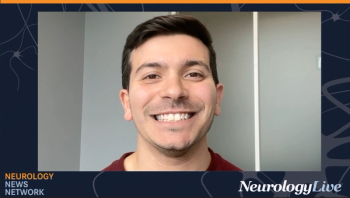
Utility of Digital Twin AI-Generated Models to Improve Patient Selection in Alzheimer Trials
Steve Herne, chief commercial officer at Unlearn, provided context on a recently conducted study assessing the company’s digital twin methodology AI tool to enhance the statistical certainty of Alzheimer trials.
Drug development for Alzheimer disease (AD), the most rapidly growing neurodegenerative disorder in the world, has changed over the years. Traditional cognitive assessments, typically done through in-person testing, have started to become more outdated, as clinicians have taken a more molecular approach to screening and treating the disease. In addition, as clinical trials have changed, the field has seen more incorporation of artificial intelligence (AI) and machine learning approaches in effort to minimize statistical uncertainty of trial outcomes.
At the
All told, results showed that depending on correlations between prognostic scores and actual trial outcomes, a potential overall sample size reduction of 5-10% could be achieved using DT methodology while maintaining statistical power, based on deltas of the CDR-SB and ADAS-Cog 14. Following the data, Steve Herne, chief commercial officer at Unlearn, provided additional insight on the findings and the utility of DT methodology. He spoke specifically about the greatest takeaways from the study, how these models differ from other AI algorithms, and the next steps in advancing these AI approaches. Overall, he talked about the clinical utility of this AI-generated model and how it may be beneficial in improving AD trials going forward.
For our clinical audience, give some details on these disease-specific AI models; how do they work?
Before diving into the AI model itself, it’s important to clarify what we mean by “digital twins,” especially given the myriad ways the term is being used in the clinical world. In our context, digital twins are AI-generated predictions that forecast a person’s health over time. These predictions are powered by deep learning models, which we refer to as digital twin generators (DTGs).
DTGs are trained on historical longitudinal clinical data that we collect from various sources like industry-sponsored studies and academic research. These deep neural networks learn how diseases progress over time, allowing us to make accurate predictions.
In the context of a clinical trial, the DTG takes baseline data from a participant and forecasts how their disease is likely to evolve. This includes predicting changes in every clinical measure that is monitored throughout the trial.
To put it simply, our goal is to align the science behind our models with the real patients in the trial. For diseases like Alzheimer’s, the model is specifically tailored to capture the nuances of that disease. This precision allows the model to generate predictions that are directly relevant to the clinical outcomes being studied, ensuring that each participant’s health profile is accurately reflected in the trial.
How are these models different from others being tested right now? What are some of their advantages early on?
What sets our model apart is how we’ve tailored our approach to predicting disease progression over time. While many people are familiar with large language models (LLMs) like those used in chatbots, our models are specifically designed to predict changes in disease, utilizing novel architectures that are well-suited for this purpose.
Many organizations lack generative AI capabilities, limiting their ability to fully leverage AI for clinical trial design and execution. By offering these advanced AI-driven models, we provide our clients with a broader lens through which they can view their clinical research, enabling insights that might otherwise be inaccessible.
Some key advantages of our approach include:
Smaller, Faster, Highly Powered Studies: By integrating digital twins into randomized studies, we can reduce the number of participants needed and accelerate study timelines. This approach is gaining recognition from regulatory bodies like the EMA and FDA.
Enhanced Trial Power: Digital twins bolster the statistical power of trial analyses, both at interim and final stages, offering greater confidence in assessing the efficacy of a treatment.
Identification of Sensitive Endpoints: The models help identify the most sensitive endpoints and composite scores by simulating digital twins that closely resemble the target patient population, which enhances the study’s sensitivity at both the population and subpopulation levels.
Subpopulation Discovery: These models allow for the identification of specific subpopulations where a drug may be particularly effective, utilizing participant-level analysis enabled by each individual’s digital twin.
Simulated Control Groups: In single-arm studies, digital twins can serve as simulated control groups, facilitating the inclusion of external comparators and providing a more detailed analysis of individual treatment responses.
Ultimately, our focus is on making clinical trials more efficient and reliable, whether that means speeding up the path to approval or quickly identifying when a drug might not be the best fit. These are the areas where our platform really shines, especially in the early stages of drug development.
Among the data, what stands out the most? Provide some thoughts on the greatest takeaways.
The results from our collaborations with AbbVie and J&J Innovative Medicine underscore the potential of using digital twins to optimize clinical trials. For instance, in our retrospective analysis of three pivotal phase 3 trials in mild-to-moderate Alzheimer’s Disease (AD) with J&J, we observed that integrating digital twins could reduce the control arm size by up to 33%. Similarly, in a phase 2 study with AbbVie, overall sample sizes were reduced by up to 15% and control arm sizes by up to 26%. Alternatively, rather than reducing sample sizes, this approach can enhance trial power, as demonstrated by a 13% power boost with ADAS-Cog11 in the J&J analysis and a 7% boost with CDR-SB in the AbbVie study.
The broader takeaway is that these findings illustrate how AI-driven approaches can address some of the persistent challenges in clinical trials. Whether it’s designing and implementing early-stage proof-of-concept studies with small sample sizes or making large, costly pivotal studies more efficient, we’re beginning to see real, tangible benefits. While many technologies have attempted to tackle these challenges before–like decentralized clinical trials (DCT) and advanced patient recruitment platforms–generative AI is proving to be a game-changer in enhancing trial design and execution.
At the AAIC conference, it was clear that there’s a growing interest in how AI can help manage the massive amounts of data generated in neurology trials, particularly in Alzheimer’s research. These trials are data-intensive and involve a lot of measurements, so it’s encouraging to see more attention being paid to the potential of AI.
Given that our work originated in Alzheimer’s research, the AAIC conference holds special significance for us. It’s where our journey began, and we remain committed to making a meaningful impact in AD trials. While our AI modeling efforts are expanding to encompass a wide range of disease states, our mission remains the same: to eliminate trial-and-error in medicine and accelerate the delivery of effective treatments to patients.
What are the next steps in advancing these AI approaches?
To advance AI approaches in clinical trials, we must focus on refining and expanding the capabilities of AI models to make them widely applicable across different therapeutic areas. One of our ongoing projects is developing a universal AI model that could predict disease progress across all human conditions. It’s early days for this research, but if we succeed, it could revolutionize how these models are used–not just in clinical trials but in areas like market access, payer decisions, and even at the point of care, where a doctor might use a digital twin to make better-informed decisions about a patient’s treatment plan.
However, to really push these AI approaches forward, we need to tackle the adoption curve in the biopharma industry. Interest is certainly growing, and we’re seeing more and more people eager to see these tools in action. But widespread adoption will take time, and it’s going to be crucial to show the real-world value of these technologies. As we move from being more research-focused to product-focused, we’re providing tangible examples–like demos and synthetic data– that help people see what’s possible. The adoption curve is steep, but we believe that as more stakeholders get on board, we’ll see a significant shift in how clinical research is conducted, leading to faster and more efficient trials.
What are some of the greatest potential long-term benefits these models may have on drug development?
The biggest long-term benefit we see with these models is their potential to drastically shorten the drug development timeline. Our goal is to implement digital twins in as many clinical trials as we can, helping to get safer, more effective drugs to patients faster and at a lower cost.
Some pharma companies are already incorporating this into their strategies, but to fully realize the potential benefits of AI in drug development, broader adoption across the industry is essential. Our collaborations with AbbVie and J&J Innovative Medicine have demonstrated the tangible advantages this technology can offer, and we’re beginning to see a shift in the industry as others take notice.
Generative AI is increasingly becoming part of the everyday language and strategy in drug development. Now that we’ve had the opportunity to collaborate with some larger companies and share our data more publicly, we’ve shown the powerful impact this technology can have. However, these benefits can only be fully realized if more companies embrace and integrate AI-driven approaches into their clinical trial processes. The potential to accelerate drug development and bring more effective treatments to market faster hinges on this collective shift.
Newsletter
Keep your finger on the pulse of neurology—subscribe to NeurologyLive for expert interviews, new data, and breakthrough treatment updates.



































